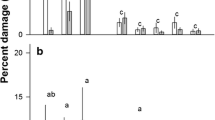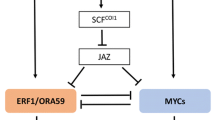Abstract
Although the production of phytohormones has been commonly associated with production of plant defence and stress-related traits, few studies have simultaneously investigated this phenomenon across several plant species that grow along large-scale ecological gradients. To address these knowledge gaps, we performed a common garden experiment with six Cardamine species, which collectively encompass an elevational gradient of 2000 m. We quantified constitutive and Pieris brassicae caterpillars-induced phytohormones and chemical defences in leaves. We found a correlated expression of phytohormone production and the subsequent induction of chemical defences, and this correlated expression reduced herbivore performance. Furthermore, we found that abiotic conditions associated with the optimal elevation range of each species influenced the production of phytohormones and chemical defences, as well as plant growth and productivity. In particular, we found that plant species adapted to milder abiotic conditions at low elevations grew faster, were more productive and produced greater levels of chemical defences. In contrast, plant species adapted to harsher abiotic conditions at high elevations tended to produce greater levels of defence-related oxylipins. Overall, these findings highlight the importance of disentangling the role of phytohormones in mediating plant adaptations to shifting biotic and abiotic conditions.






Similar content being viewed by others
References
Aeschimann D, Lauber K, Moser DM, Theurillat J-P (2004) Flora Alpina. Haupt, Berne
Ahmad P, Rasool S, Gul A, Sheikh SA, Akram NA, Ashraf M, Kazi AM, Gucel S (2016) Jasmonates: multifunctional roles in stress tolerance. Front Plant Sci 7:813
Bodenhausen N, Reymond P (2007) Signaling pathways controlling induced resistance to insect herbivores in Arabidopsis. Mol Plant-Microbe Interact 20(11):1406–1420
Coley P (1998) Possible effects of climate change on plant/herbivore interactions in moist tropical forests. Clim Chang 39(2–3):455–472
Creelman RA, Mullet JE (1995) Jasmonic acid distribution and action in plants: regulation during development and response to biotic and abiotic stress. Proc Natl Acad Sci U S A 92(10):4114–4119
Danquah A, de Zelicourt A, Colcombet J, Hirt H (2014) The role of ABA and MAPK signaling pathways in plant abiotic stress responses. Biotechnol Adv 32(1):40–52
De Ollas C, Arbona V, Gomez-Cadenas A, Dodd IC (2018) Attenuated accumulation of jasmonates modifies stomatal responses to water deficit. J Exp Bot 69(8):2103–2116
Defossez E, Pellissier L, Rasmann S (2018) The unfolding of plant growth form-defence syndromes along elevation gradients. Ecol Lett 21(5):609–618
Demkura PV, Abdala G, Baldwin IT, Ballaré CL (2010) Jasmonate-dependent and -independent pathways mediate specific effects of solar ultraviolet B radiation on leaf phenolics and antiherbivore defense. Plant Physiol 152(2):1084–1095
Descombes P, Marchon J, Pradervand J-N, Bilat J, Guisan A, Rasmann S, Pellissier L (2017) Community-level plant palatability increases with elevation as insect herbivore abundance declines. J Ecol 105(1):142–151
Díaz S, Kattge J, Cornelissen JHC, Wright IJ, Lavorel S, Dray S, Reu B, Kleyer M, Wirth C, Colin Prentice I et al (2016) The global spectrum of plant form and function. Nature 529(7585):167–171
Dobzhansky T (1950) Evolution in the tropics. Am Sci 38:209–221
Dray S, Dufour AB (2007) The ade4 package: implementing the duality diagram for ecologists. J Stat Softw 22(4):1–20
Dray S, Chessel D, Thioulouse J (2003) Co-inertia analysis and the linking of ecological data tables. Ecology 84(11):3078–3089
Erb M, Glauser G, Robert CAM (2012a) Induced immunity against belowground insect herbivores- activation of defenses in the absence of a jasmonate burst. J Chem Ecol 38(6):629–640
Erb M, Meldau S, Howe GA (2012b) Role of phytohormones in insect-specific plant reactions. Trends Plant Sci 17(5):250–259
Farmer EE, Alméras E, Krishnamurthy V (2003) Jasmonates and related oxylipins in plant responses to pathogenesis and herbivory. Curr Opin Plant Biol 6(4):372–378
Fujita M, Fujita Y, Noutoshi Y, Takahashi F, Narusaka Y, Yamaguchi-Shinozaki K, Shinozaki K (2006) Crosstalk between abiotic and biotic stress responses: a current view from the points of convergence in the stress signaling networks. Curr Opin Plant Biol 9(4):436–442
Grosser K, van Dam NM (2017) A straightforward method for glucosinolate extraction and analysis with high-pressure liquid chromatography (HPLC). J Vis Exp (121):55425
Gupta A, Hisano H, Hojo Y, Matsuura T, Ikeda Y, Mori IC, Senthil-Kumar M (2017) Global profiling of phytohormone dynamics during combined drought and pathogen stress in Arabidopsis thaliana reveals ABA and JA as major regulators. Sci Rep 7(1):4017
Horváth E, Szalai G, Janda T (2007) Induction of abiotic stress tolerance by salicylic acid signaling. J Plant Growth Regul 26(3):290–300
Howe GA, Jander G (2008) Plant immunity to insect herbivores. Annu Rev Plant Biol 59:41–66
Huang W, Robert CAM, Hervé MR, Hu L, Bont Z, Erb M (2017) A mechanism for sequence specificity in plant-mediated interactions between herbivores. New Phytol 214(1):169–179
Iqbal N, Umar S, Khan NA, Khan MIR (2014) A new perspective of phytohormones in salinity tolerance: regulation of proline metabolism. Environ Exp Bot 100:34–42
Ismail A, Riemann M, Nick P (2012) The jasmonate pathway mediates salt tolerance in grapevines. J Exp Bot 63(5):2127–2139
Jeandroz S, Lamotte O (2017) Editorial: plant responses to biotic and abiotic stresses: lessons from cell signaling. Front Plant Sci 8:1772
Jiang Z, Guo H (2010) A comparative genomic analysis of plant hormone related genes in different species. J Genet Genomics 37(4):219–230
Kessler A, Baldwin IT (2002) Plant responses to insect herbivory: the emerging molecular analysis. Annu Rev Plant Biol 53:299–328
Khan MIR, Fatma M, Per TS, Anjum NA, Khan NA (2015) Salicylic acid-induced abiotic stress tolerance and underlying mechanisms in plants. Front Plant Sci 6:462–462
Körner C (2003) Alpine plant life: functional plant ecology of high mountain ecosystems. Springer, Berlin
Körner C (2007) The use of 'altitude' in ecological research. Trends Ecol Evol 22(11):569–574
Kramell R, Schmidt J, Schneider G, Sembdner G, Schreiber K (1988) Synthesis of n-(jasmonoyl)amino acid conjugates. Tetrahedron 44(18):5791–5807
Latif F, Ullah F, Mehmood S, Khattak A, Khan AU, Khan S, Husain I (2016) Effects of salicylic acid on growth and accumulation of phenolics in Zea mays L. under drought stress. Acta Agric Scand B Soil Plant Sci 66(4):325–332
Mittler R, Blumwald E (2015) The roles of ROS and ABA in systemic acquired acclimation. Plant Cell 27(1):64–70
Moons A, Prinsen E, Bauw G, Van Montagu M (1997) Antagonistic effects of abscisic acid and jasmonates on salt stress-inducible transcripts in rice roots. Plant Cell 9(12):2243–2259
Müller C, van Loon J, Ruschioni S, De Nicola GR, Olsen CE, Iori R, Agerbirk N (2015) Taste detection of the non-volatile isothiocyanate moringin results in deterrence to glucosinolate-adapted insect larvae. Phytochemistry 118:139–148
Nejat N, Mantri N (2017) Plant immune system: crosstalk between responses to biotic and abiotic stresses the missing link in understanding plant defence. Curr Issues Mol Biol 23:1–16
Oksanen J, Blanchet FG, Kindt R, Legendre P, Minchin PR, O'Hara RB, Simpson GL, Solymos P, Stevens MHH, Wagner H (2013) Vegan: community ecology package. Version 2.0-10: http://vegan.r-forge.r-project.org/
Okuma E, Nozawa R, Murata Y, Miura K (2014) Accumulation of endogenous salicylic acid confers drought tolerance to Arabidopsis. Plant Signal Behav 9(3):e28085
Pedranzani H, Sierra-de-Grado R, Vigliocco A, Miersch O, Abdala G (2007) Cold and water stresses produce changes in endogenous jasmonates in two populations of Pinus pinaster Ait. Plant Growth Regul 52(2):111–116
Peleg Z, Blumwald E (2011) Hormone balance and abiotic stress tolerance in crop plants. Curr Opin Plant Biol 14(3):290–295
Pellissier L, Fiedler K, Ndribe C, Dubuis A, Pradervand J-N, Guisan A, Rasmann S (2012) Shifts in species richness, herbivore specialization, and plant resistance along elevation gradients. Ecol Evol 2(8):1818–1825
Pellissier L, Moreira X, Danner H, Serrano M, Salamin N, van Dam NM, Rasmann S (2016) The simultaneous inducibility of phytochemicals related to plant direct and indirect defences against herbivores is stronger at low elevation. J Ecol 104(4):1116–1125
Pieterse CMJ, Leon-Reyes A, Van der Ent S, Van Wees SCM (2009) Networking by small-molecule hormones in plant immunity. Nat Chem Biol 5(5):308–316
Pieterse CMJ, Van der Does D, Zamioudis C, Leon-Reyes A, Van Wees SCM (2012) Hormonal modulation of plant immunity. In: Schekman R, editor. Annu Rev Cell Dev Biol 28:489–521
R Development Core Team (2017) R: a language and environment for statistical computing. R Foundation for Statistical Computing, Vienna
Rasmann S, Alvarez N, Pellissier L. 2014a. The altitudinal niche-breadth hypothesis in insect-plant interactions. In: Voelckel C, Jander G, editors. Annual Plant Reviews, Volume 47, Insect-Plant Interactions: Wiley p 339–359
Rasmann S, Pellissier L, Defossez E, Jactel H, Kunstler G (2014b) Climate-driven change in plant–insect interactions along elevation gradients. Funct Ecol 28(1):46–54
Rasmann S, Chassin E, Bilat J, Glauser G, Reymond P (2015) Trade-off between constitutive and inducible resistance against herbivores is only partially explained by gene expression and glucosinolate production. J Exp Bot 66(9):2527–2534
Reymond P, Bodenhausen N, Van Poecke RMP, Krishnamurthy V, Dicke M, Farmer EE (2004) A conserved transcript pattern in response to a specialist and a generalist herbivore. Plant Cell 16(11):3132–3147
Riemann M, Dhakarey R, Hazman M, Miro B, Kohli A, Nick P (2015) Exploring jasmonates in the hormonal network of drought and salinity responses. Front Plant Sci 6(1077)
Rosseel Y (2012) lavaan: An R package for structural equation modeling. J Stat Softw 48(2):36
Schemske DW (2009) Biotic interactions and speciation in the tropics. In: Butlin RK, Bridle JR, Schluter D (eds) Speciation and patterns of diversity. Cambridge Univ. Press, Cambridge, pp 219–239
Schmidt A, Nagel R, Krekling T, Christiansen E, Gershenzon J, Krokene P (2011) Induction of isoprenyl diphosphate synthases, plant hormones and defense signalling genes correlates with traumatic resin duct formation in Norway spruce (Picea abies). Plant Mol Biol 77(6):577–590
Shinozaki K, Yamaguchi-Shinozaki K (2007) Gene networks involved in drought stress response and tolerance. J Exp Bot 58(2):221–227
Suhita D, Kolla VA, Vavasseur A, Raghavendra AS (2003) Different signaling pathways involved during the suppression of stomatal opening by methyl jasmonate or abscisic acid. Plant Sci 164(4):481–488
Thaler JS, Humphrey PT, Whiteman NK (2012) Evolution of jasmonate and salicylate signal crosstalk. Trends Plant Sci 17(5):260–270
Ton J, Flors V, Mauch-Mani B (2009) The multifaceted role of ABA in disease resistance. Trends Plant Sci 14(6):310–317
Tuteja N, Sopory SK (2008) Chemical signaling under abiotic stress environment in plants. Plant Signal Behav 3(8):525–536
van Dam NM, Witjes L, Svatos A (2004) Interactions between aboveground and belowground induction of glucosinolates in two wild Brassica species. New Phytol 161(3):801–810
Wahid A, Gelani S, Ashraf M, Foolad MR (2007) Heat tolerance in plants: an overview. Environ Exp Bot 61(3):199–223
War AR, Paulraj MG, War MY, Ignacimuthu S (2011) Role of salicylic acid in induction of plant defense system in chickpea (Cicer arietinum L.). Plant Signal Behav 6(11):1787–1792
Wright IJ, Reich PB, Westoby M, Ackerly DD, Baruch Z, Bongers F, Cavender-Bares J, Chapin T, Cornelissen JHC, Diemer M et al (2004) The worldwide leaf economics spectrum. Nature 428(6985):821–827
Yoon JY, Hamayun M, Lee S-K, Lee I-J (2009) Methyl jasmonate alleviated salinity stress in soybean. J Crop Sci Biotechnol 12(2):63–68
Zamioudis C, Pieterse CM (2012) Modulation of host immunity by beneficial microbes. Mol Plant-Microbe Interact 25(2):139–150
Zhang Y, Xu S, Yang S, Chen Y (2015) Salicylic acid alleviates cadmium-induced inhibition of growth and photosynthesis through upregulating antioxidant defense system in two melon cultivars (Cucumis melo L.). Protoplasma 252(3):911–924
Zimmermann N, Kienast F (1999) Predictive mapping of alpine grasslands in Switzerland: species versus community approach. J Veg Sci 10:469–482
Acknowledgments
We are grateful to Julia Bilat who helped with plant trait sampling. We thank Nichole Wetter for commenting on earlier versions of the manuscript. This research was financially supported by a Swiss National Science Foundation grant 31003A_159869 to SR. NMvD was supported by the German Centre for Integrative Biodiversity Research (iDiv) Halle-Jena-Leipzig funded by the German Research Foundation (FZT 118).
Author information
Authors and Affiliations
Corresponding author
Rights and permissions
About this article
Cite this article
Robert, C.A.M., Pellissier, L., Moreira, X. et al. Correlated Induction of Phytohormones and Glucosinolates Shapes Insect Herbivore Resistance of Cardamine Species Along Elevational Gradients. J Chem Ecol 45, 638–648 (2019). https://doi.org/10.1007/s10886-019-01084-2
Received:
Revised:
Accepted:
Published:
Issue Date:
DOI: https://doi.org/10.1007/s10886-019-01084-2




